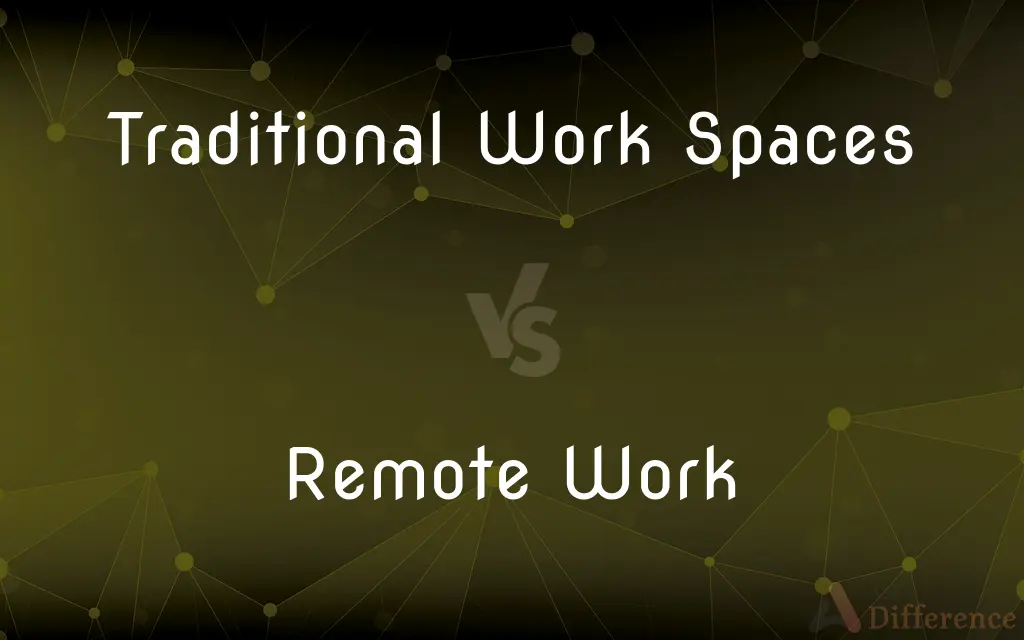Traditional Work Spaces vs. Remote Work — What's the Difference?
By Tayyaba Rehman — Published on January 17, 2024
Traditional Work Spaces refer to physical office environments where employees work together, while Remote Work involves working from anywhere outside the traditional office, often from home.

Difference Between Traditional Work Spaces and Remote Work
Table of Contents
ADVERTISEMENT
Key Differences
Traditional Work Spaces are physical locations like offices where employees gather to perform their job functions. Remote Work allows employees to work from various locations, including their homes, cafes, or any place with an internet connection.
In Traditional Work Spaces, face-to-face interactions and in-person meetings are common. In contrast, Remote Work relies heavily on digital communication tools for collaboration and meetings.
Traditional Work Spaces often involve a structured routine with set working hours. Remote Work offers more flexibility in terms of work hours and environment, often leading to better work-life balance.
Traditional Work Spaces typically require commuting, which can add to an employee’s workday. Remote Work eliminates commuting, saving time and potentially reducing stress.
While Traditional Work Spaces can foster a sense of community and easier collaboration, Remote Work can lead to isolation but offers the advantage of a customizable work environment.
ADVERTISEMENT
Comparison Chart
Location
Physical office environment
Any location with internet access
Interaction
Face-to-face meetings and collaboration
Digital communication and virtual meetings
Work Routine
Structured, with set hours
Flexible, with potential for varied hours
Commuting
Required
None, work from anywhere
Environment Impact
Fixed, office setting
Customizable, chosen by the employee
Compare with Definitions
Traditional Work Spaces
Involves face-to-face collaboration.
Traditional work spaces foster direct interactions among team members.
Remote Work
Relies on digital tools for communication.
Remote work is facilitated by video conferencing and online collaboration tools.
Traditional Work Spaces
Requires commuting to the office.
Employees at traditional work spaces often face daily commutes.
Remote Work
Working from anywhere outside a traditional office.
She enjoys remote work because she can work from her home office.
Traditional Work Spaces
A physical office setting for work.
Their company maintains traditional work spaces in downtown buildings.
Remote Work
Eliminates the need for daily commuting.
Remote work has saved her two hours of commuting every day.
Traditional Work Spaces
Structured routine with set hours.
Traditional work spaces typically operate 9-to-5.
Remote Work
Offers flexible work hours and environment.
Remote work allows him to adjust his schedule for better work-life balance.
Traditional Work Spaces
Provides a sense of community.
Traditional work spaces help build a strong company culture.
Remote Work
Can be done from home, cafes, or co-working spaces.
He sometimes works remotely from a local coffee shop for a change of scenery.
Common Curiosities
Can traditional workspaces enhance collaboration?
Yes, they facilitate better face-to-face collaboration.
What is a traditional workspace?
It's a physical office where employees work together.
Are traditional workspaces flexible?
Generally, they have set hours and less flexibility compared to remote work.
What are the benefits of traditional workspaces?
They offer direct communication, structured routines, and a sense of community.
Can remote work improve work-life balance?
Yes, it offers more flexibility in work hours and environment.
What is remote work?
Working from anywhere outside of a traditional office, often from home.
Can remote work be done internationally?
Yes, as long as there's internet access and alignment with time zones if needed.
Do traditional workspaces require commuting?
Yes, employees need to commute to the office location.
What tools are essential for remote work?
Digital communication tools like video conferencing and online collaboration platforms.
Is remote work suitable for all job roles?
It depends on the nature of the job; some roles may require a physical presence.
How does remote work affect commuting?
It eliminates the need for daily commuting.
Can remote work lead to isolation?
Yes, it can lead to a sense of isolation due to lack of in-person interactions.
Is productivity higher in traditional workspaces or remote work?
It varies; some find traditional settings more productive, while others thrive in remote work.
How do companies communicate with remote workers?
Through digital tools like email, chat applications, and video calls.
Are there cost benefits to remote work?
Yes, it can save costs related to commuting and office maintenance.
Share Your Discovery

Previous Comparison
Reversible Process vs. Irreversible Process
Next Comparison
Food Chain vs. Food WebAuthor Spotlight
Written by
Tayyaba RehmanTayyaba Rehman is a distinguished writer, currently serving as a primary contributor to askdifference.com. As a researcher in semantics and etymology, Tayyaba's passion for the complexity of languages and their distinctions has found a perfect home on the platform. Tayyaba delves into the intricacies of language, distinguishing between commonly confused words and phrases, thereby providing clarity for readers worldwide.











































